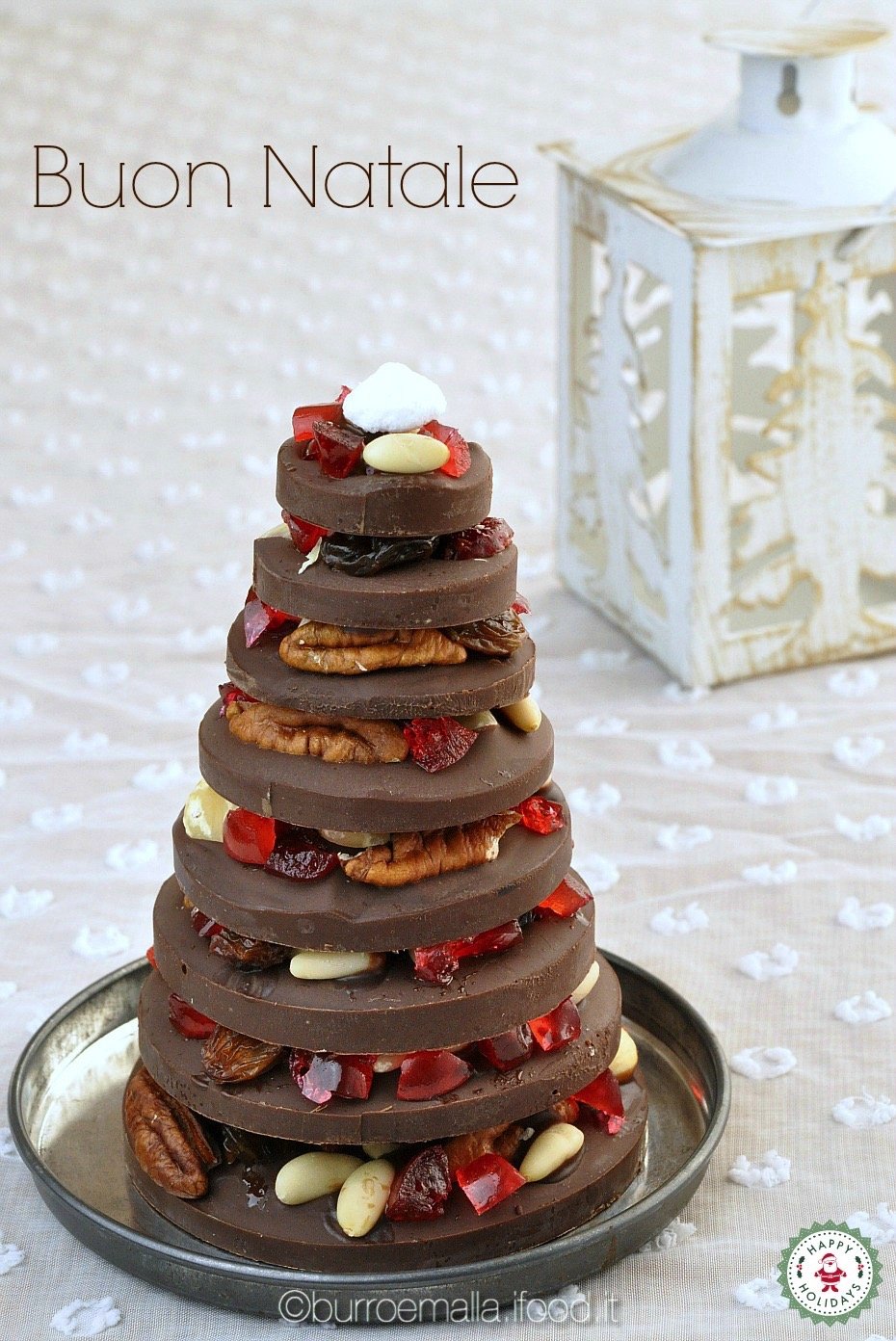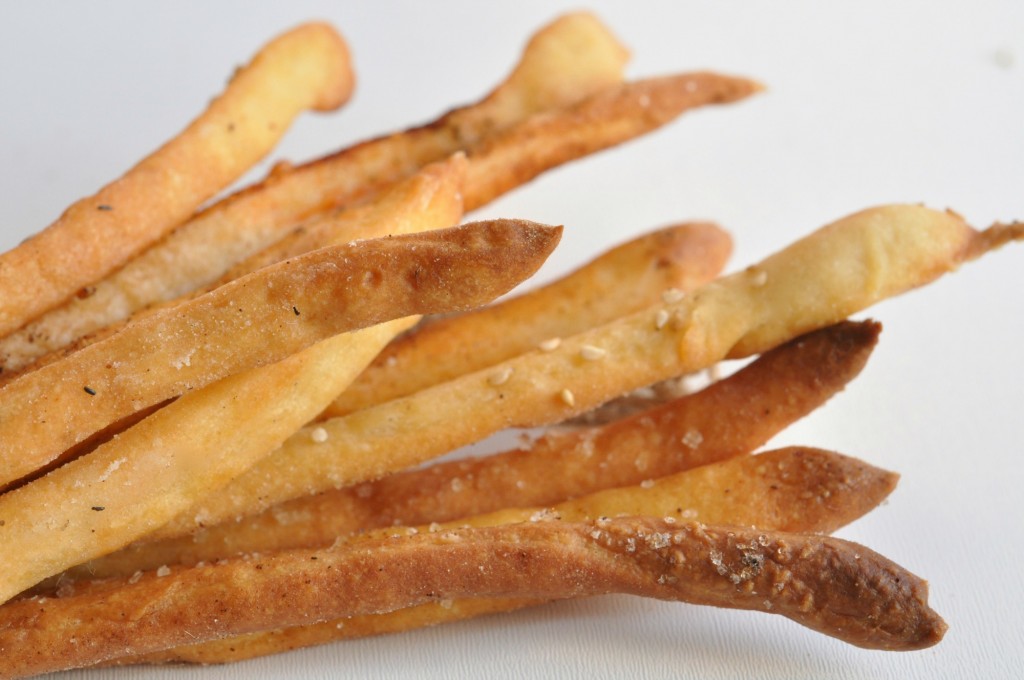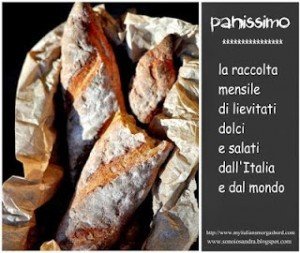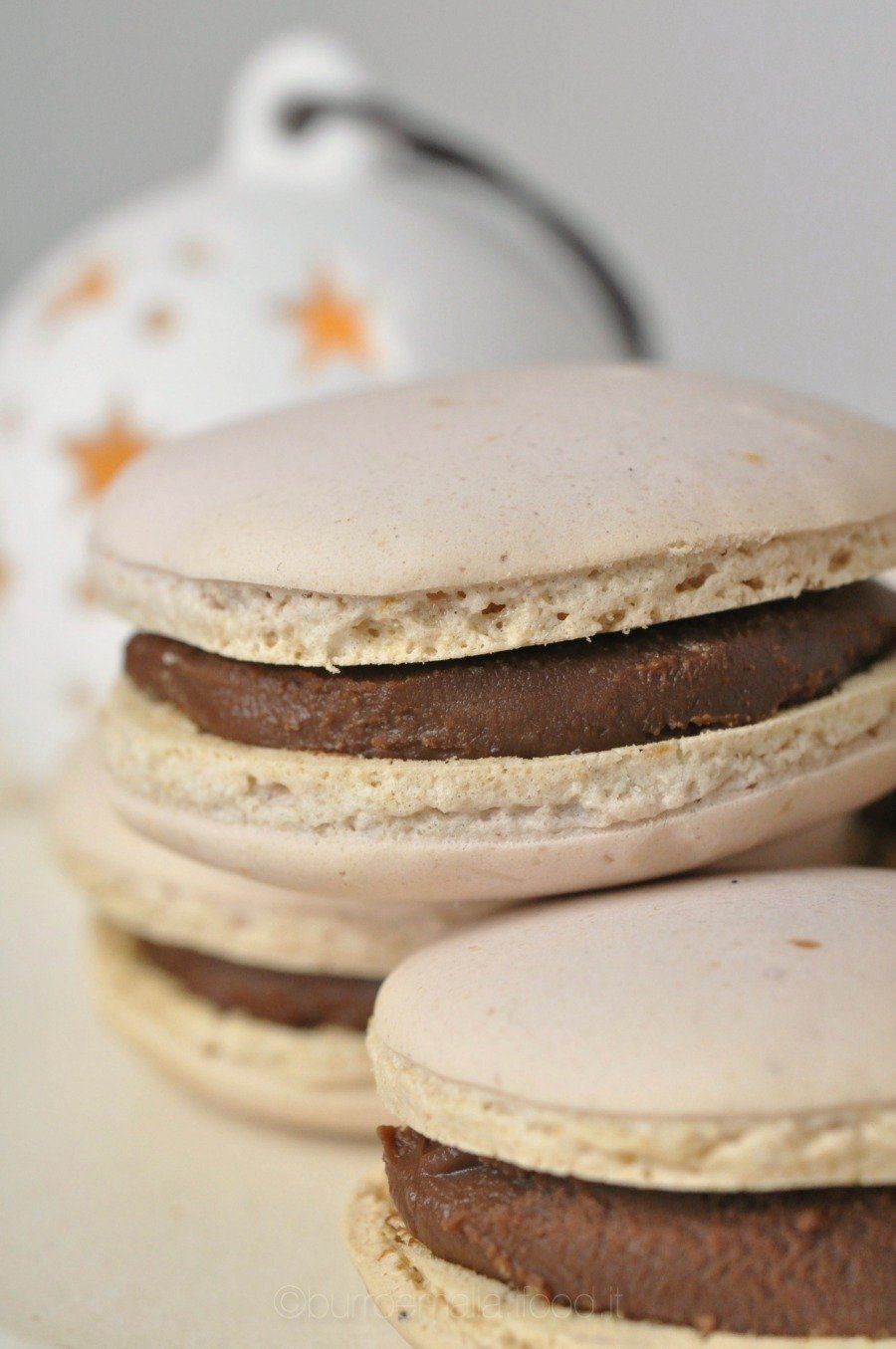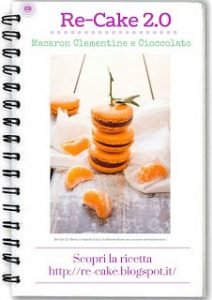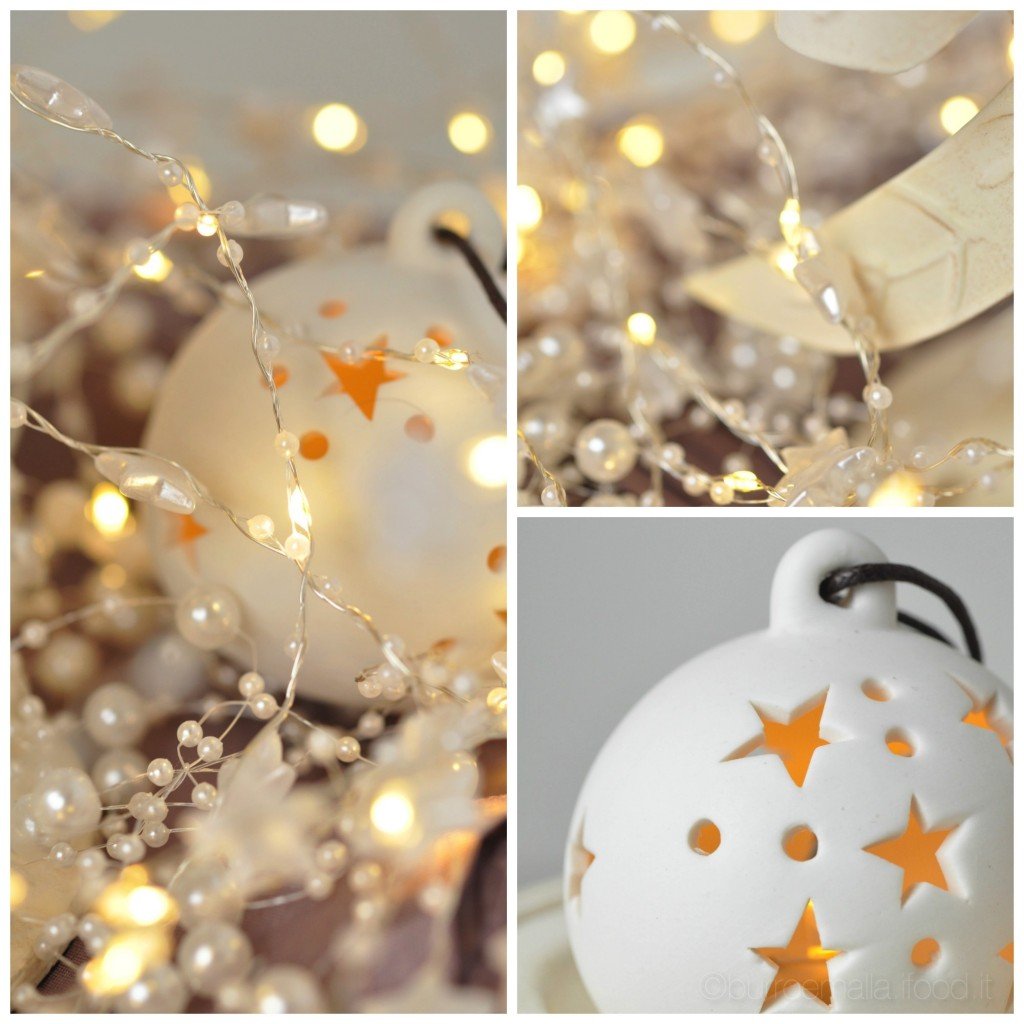Giuro, questo è l’ultima ricetta di pasticceria francese che propongo nel mese di gennaio ma già mentre lo affermo sto cercando una scappatoia per farlo di nuovo. Il fatto è che le ricette sono così particolari, così piene di spunti che proprio non resisto. Questo dolce ne è il perfetto esempio. Un classicissimo pound cake che viene però impreziosito da una meringa al cioccolato che lo riveste nel quale sono incastonate lamelle di mandorle e riempito con una ganache al cioccolato che oltre a donare contrasto alla consistenza, crea un disegno all’interno del dolce. Ovvio che poi il sapore non è più quello di un semplice pound cake tanto che mio padre, risaputamente ipercritico in tutto quello che faccio, ricette e non, sempre pronto ad affermare che -sì, questo dolce è buono ma manca un pizzico di zucchero/si doveva cuocere un pelino meno/lo trovo un po’ troppo dolce-, per la prima volta nella vita dopo averlo assaggiato ha detto solo: “Notevole” e questo complimento me lo faccio bastare per sempre! La preparazione non è proprio di quelle nelle quali ci si butta all’ultimo momento ma si può dividere il lavoro in steps e il risultato comunque vi ripagherà abbondantemente. Questa volta la ricetta è di Pfeiffer, altro straordinario pasticcere che ho scoperto nel corso del mio lento avvicinamento al mistero della pasticceria francese e non mi ha fatto rimpiangere Hermé. Ma sono tutti così bravi?
- 60 g burro ammorbidito (per lo stampo)
- 100 g di mandorle a lamelle
- 32 g di cacao in polvere (che andrà nella meringa)
- 120 g di zucchero a velo (che andrà nella meringa)
- 150 g di farina di mandorle
- 40 g di farina 00
- 36 g di amido di mais
- 104 g di burro all'82% di grassi
- 160 g di farina di mandorle (che andrà nella meringa)
- 60 g di zucchero a velo
- 100 g di tuorli d'uovo (6 tuorli)
- 40 g di miele (la ricetta prevedeva miele di trifoglio
- 100 g di uova intere (1 uovo)
- 2 cucchiaini di estratto naturale di vaniglia
- Scorza grattugiata di un limone non trattato
- Scorza grattugiata di mezza arancia non trattata
- 320 g di albumi (9 albumi)
- 160 g di zucchero granulato
- Per la ganache:
- 150 g cioccolato di copertura al 64%
- 25 g di burro all'82%
- 10 g di miele
- ¼ di stecca di vaniglia
- 135 g di panna fresca
- Imburrate generosamente lo stampo con il burro ammorbidito e versate al suo interno le lamelle di mandorla inclinandolo in ogni direzione in modo da avere le mandorle distribuite uniformemente al suo interno. Capovolgete lo stampo per far cadere quelle in eccesso quindi mettete lo stampo in frigo per 15 minuti.
- Preriscaldate il forno a 180° con la griglia posizionata al centro.
- Setacciate il cacao, i 120 g di zucchero a velo e i 160 g di farina di mandorle direttamente su di un foglio di carta forno e mettete da parte.
- Setacciate la farina 00 e l’amido di mais sopra un altro foglio di carta forno e mettete anche questo da parte.
- Per il beurre noisette, usato molto spesso nella pasticceria francese per lo straordinario profumo di nocciola che conferisce, mettete il burro in un tegamino su fuoco bassissimo, fate sciogliere e poi mescolate lentamente con una spatola per 5/7 minuti, finché non scurirà. Trasferitelo quindi in una ciotola per interrompere il processo. Fate freddare per 5 minuti.
- Nel frattempo setacciate i 150 g di farina di mandorle rimanenti e i 60 g di zucchero a velo e metteteli all’interno della ciotola della planetaria insieme ai tuorli, il miele, le uova intere e l’estratto di vaniglia e usando la frusta K montate a velocità media per 5 minuti, finché l’impasto non sarà chiaro e spumoso. Aggiungete il beurre noisette tiepido e montate sempre a velocità media per altri 30 secondi. Travasate il tutto dentro una ciotola capiente e usando una spatola grande, incorporatevi le scorze di limone ed arancia e la farina/amido di mais che avevate setacciato su carta forno facendo attenzione a introdurre aria nell’impasto.
- Lavate bene la ciotola dell’impastatrice togliendo ogni residuo di grassi perché ora dovrete usarla per la meringa. Sostituite la frusta K con la frusta e passate subito allo step successivo per non far riposare troppo l’impasto di farina e uova.
- Mettete gli albumi nella ciotola e montate a velocità media per 10 secondi. Aggiungete lo zucchero granulato e aumentate la velocità al massimo montando per un altro minuto e mezzo, due minuti. La meringa deve risultare ancora morbida e non asciutta.
- Prendete una bilancia e pesate 240 g di meringa in una piccola ciotola.
- A questi 240 g aggiungete l’impasto farina/uova mescolando di nuovo con una spatola grande per incorporare aria. Non lavorate troppo o l’impasto si sgonfierà e il vostro dolce risulterà asciutto.
- Tornate ora alla meringa ancora nella ciotola dell’impastatrice e continuate a montare a velocità bassa per evitare che si sgonfi.
- Staccate, prendete la ciotola con la meringa dalla planetaria e usando una spatola morbida incorporate gentilmente la mistura cacao/zucchero a velo/farina di mandorle che riposava sul foglio di carta forno.
- Ora, usando una spatola di metallo, preferibilmente del tipo che si usa per temperare il cioccolato, rivestitevi lo stampo foderato di mandorle per creare un guscio di meringa al cioccolato.
- Riempite quindi con l’impasto farina/uova e livellate usando una spatola. Dovrete riempire lo stampo per due terzi.
- Posizionate in forno e cuocete per 25 minuti circa a 180°, successivamente riducete il calore a 160° e cuocete per altri 20 minuti. Togliete dal fuoco, fate la prova stecchino (i francesi usano la lama di un coltellino) e sformate immediatamente il pound cake su di una griglia e rivestitelo con un canovaccio all’interno del quale lo lascerete riposare per un’ora.
- Nel frattempo preparerete la ganache (che per praticità potrà essere preparata il giorno prima)
- Se avanzerà, potete tranquillamente congelarla e poi usarla per altre preparazioni come, per esempio, aggiungendone un cucchiaio ad una tazza di latte caldo.
- Se non userete pastiglie di cioccolato del resto abbastanza difficili da reperire, almeno nella mia zona, mettete la vostra stecca di cioccolato su di un tagliere e usando il coltello con la lama più grande che possedete, tagliatela a striscioline e successivamente a pezzettini di mezzo cm.
- È' molto importante che i pezzetti siano uniformi.
- In una ciotola da microonde ammorbidite il burro a temperatura ambiente insieme al miele usando una spatola di silicone. Eventualmente riscaldate per 5 secondi ma fate attenzione perché non si devono sciogliere altrimenti la ganache risulterà unta.
- Mettete il cioccolato in un'altro contenitore da microonde e fate andare ad intervalli di 30 secondi al 50% di potenza. Il cioccolato dovrà risultare semi-fuso con parti già sciolte e altre non ancora.
- Aprite la stecca di vaniglia e prelevatene ¼ dei semi.
- Mettete la panna fresca in un tegamino, unite i semi di vaniglia e il pezzetto di stecca e portare ad ebollizione. Filtrate e versate immediatamente nella ciotola contenente il cioccolato. Coprite con pellicola trasparente e fate riposare per 1 minuto, quindi togliete la pellicola facendo cadere nel cioccolato la condensa formatasi e poi, usando una spatola di silicone, incominciate a mescolare facendo dei piccoli cerchi all'interno della miscela panna/cioccolato e solo quando vedrete che si formerà un emulsione tra grassi e acqua allargherete i cerchi verso l'esterno i+fino a quando la panna ed il cioccolato non si trasformeranno in una miscela liscia e densa.
- Ora si dovrà aggiungere il burro ma qui entra in gioco la temperatura. Quella che la ganache dovrà avere prima di aggiungerlo è tra 38 e 40% Se è superiore, scioglierà istantaneamente il burro e questo le farà perdere cremosità. Se invece è troppo fredda il risultato sarà l'equivalente di far impazzire la maionese cioè le componenti si separeranno.
- Mescolate prima con una piccola frusta e poi finite con un mixer ad immersione per 30 secondi, finché la ganache non sarà lucida e liscia.
- Fate freddare in frigo 30 minuti prima di usarla.
- Pesatene 150 g e conservate il resto che potrete tranquillamente congelare e poi usare per altre preparazioni come, per esempio, aggiungendone un cucchiaio ad una tazza di latte caldo.
- Mettete il pound cake su di un tagliere con il fondo rivolto verso l’alto e usando un coltello per il pane praticate un taglio a V che va dall’esterno verso l’interno e rimuovere la fetta triangolare con molta attenzione.
- Ora ricoprite la superficie del taglio a V con la ganache e poi rimettere il “tappo” di torta, pressando leggermente perché aderisca e riprenda la forma originale.
- Rimettete in frigo almeno per 30 minuti in modo da permettere alla ganache di compattarsi bloccando a se il tappo.
- Prima di servire tenere a temperatura ambiente per mezz’ora.
- Il dolce si conserva in frigo per due o tre giorni avvolto in pellicola trasparente.
English version
Directly from the Jacquy Pfeiffer’s recipe in The art of French pastry
Ingredients:
60 g soft butter (for the pan)
150 sliced almonds
32 g cocoa powder
120 g icing sugar
160 g almond flour
40 g cake flour
36 g cornstarch
104 g unsalted butter (82 % fat)
150 g almond flour
60 g icing sugar
100 g egg yolks (6 yolks)
40 g honey
100 g whole eggs (2 eggs)
10 g vanilla extract
Zest of 1 lemon
Zest of 1/2 orange
320 g egg whites (9 whites)
160 g granulated sugar
Ganache:
150 g dark chocolaté couverture (64%)
25 g unsalted butter (82% fat)
10 g honey
1/4 vanilla bean
135 g fresh double cream
Using a brush, grease a loaf pan very generously with soft butter and pour the sliced almonds into it. Tilt the pan in all directions so that the almonds coat the sides thoroughly and evenly, forming a natural outside lining of your cake. Once the sides are coated, turn the pan over and allow the excess almonds to fall out. Set the excess aside for another purpose and place the pan in the refrigerator for 15 minutes. Preheat the oven to 180°C with the rack positioned in the center. Sift the cocoa powder, 120 g of confectioners’ sugar, and 160 g of sifted almond flour together onto a sheet of parchment paper and set aside. Sift the cake flour together with the cornstarch onto another piece of parchment paper or into a small bowl and set aside. Place the butter in a small saucepan and set over low heat. Allow the butter to melt, then stir slowly with the spatula until it turns light brown, about 5 to 7 minutes. Remove from the heat and strain into a small bowl so that it does not continue to brown. Set it aside to cool for 5 minutes. Meanwhile, place remaining 150 g sifted almond flour, 60 g sifted confectioners’ sugar, the egg yolks, honey, whole egg, and vanilla in the bowl of your stand mixer fitted with the paddle. Mix on medium speed for 5 minutes, until the mixture is pale and light. Add the lukewarm browned butter and mix on medium speed for 30 seconds. Take the bowl out of the mixer and scrape out the mixture into a large bowl. Using a wide spatula, gently fold in the lemon and orange zests and the cake flour and cornstarch mixture. Wash the mixer bowl thoroughly with hot, soapy water, rinse, dry, and return to the stand. Change to the whisk attachment. Immediately move on to the next step so that the flour does not sit too long in the egg mixture. Place the egg whites in the bowl of your mixer fitted with the whisk. Whip on medium speed for 10 seconds. Add the granulated sugar and whip for 1a to 2 full minutes on high speed, until semi-stiff but not dry. Remove the mixing bowl from the machine, place a small bowl on your scale, and weigh out 240 grams of the meringue. Fold this into the egg yolk mixture. Do not over-fold or you will deflate the batter and your cake will be tough. Return the mixing bowl to the machine and continue to whip the remaining meringue on the lowest speed just to maintain it. Stop the mixer, take out the bowl and, using a rubber spatula, gently fold in the cocoa powder mixture. Scrape into the almond- lined bread pan and, using a small offset spatula, gently spread it evenly all over the sides and bottom of the pan to create a chocolate meringue shell. Fill the chocolate shell with the cake batter and smooth the top with the small offset spatula. The pan will be about 2/3 full. Place the mold on a sheet pan and bake for 25 minutes at 180°C. Reduce the heat to 160°C and bake for another 20 minutes, until firm. Insert the tip of a paring knife into the center of the cake; it should come out clean. If it does not, bake for another 5 to 10 minutes. Remove from the oven and immediately reverse the cake onto a wire rack, unmold, and gently wrap the cake in a towel. Allow the cake to cool to room temperature; this will take 1 hour. Place the chocolate block on a cutting boarding using the largest chef’s knife you own, shave the chocolate from the top down, then cut into 1/4 inch pieces. If you are using coins no need to chop them. In a microwave bowl soften the butter and honey using a rubber spatula. If too firm, microwave it for 5 seconds but do not melt it or your ganache will be greasy. Place the chopped chocolate in another microwave bowl and microwave it 5 seconds by 5 seconds at 50 percent power. The chocolate should be semi-melted. You must obtain some melted chocolate and some that is still hard. Split the vanilla bean and scrape the seeds then place in a medium saucepan together with the bean and the heavy cream and bring to boil. Remove from the heat and remove the vanilla bean. Pour it immediately over the chocolate and cover with plastic wrap and let it stand for 1 minute then remove it letting the condensation into the ganache. Using a rubber spatula start stirring the mixture from the inside out with small circles. Once you will see the mixture is beginning to emulsify you you will make wider circles until the cream and the chocolate will be completely homogenized into a thick, smooth mixture. Now you will add butter but the ganache temperature will have to be between 38° and 40°. Once the temperature will be the right one, add the butter. Mix it first with a small whisk and immediately finish with an immersion blender for about 30 seconds, until the ganache will be smooth and shiny. Place the cake on a cutting board with the bottom facing up. Using a long serrated knife, create a V cut by slicing from the edge of the cake to the middle on an inward 45- degree angle. Repeat on the other side of the cake so that you can now remove the triangular slice.
Using a small offset spatula, spread the surface of the V cut with the ganache. Return the triangular slice to the cake, setting it right on top of the ganache filling and pressing down gently but firmly so that it sticks to the ganache. Place the cake back in its original mold and refrigerate for 30 minutes. This will allow the ganache to set and keep the whole cake together. Let it come to room temperature for 30 minutes and unmold. The cake is now ready to be served. This cake keeps in a cool place for 2 to 3 days wrapped in plastic wrap.

















